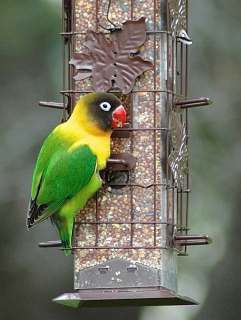Masked Lovebird |
|
|
Also known as: Yellow-collared Lovebird, Black-masked Lovebird, Black-faced Lovebird, Black-headed Lovebird
Photos
View in GalleryDid You Know?
The scientific name for Masked Lovebird is Agapornis personata. "Agapornis" is from the Greek "agapein" which means "to love" and the Latin "ornis" which means "bird."Academic Research
Related publications: Agapornis personatusSpecies Profile
Genus: Agapornis | Species: personatus
Size:
14.5cm (5.6 in)
Weight:
43-50g (1.5-1.75 oz)
Subspecies including nominate:
one
Colour Adult:
Both adults brown/black crown and face; dusky olive green rest of head; red/orange throat; yellow breast and wide collar around neck; dull blue upper tail coverts; green tail, with the lateral feathers dull orange at base and banded near ends with black. Bill deep red. Eye dark brown.
Colour Juvenile:
In general are duller than the adults, in particular the more brown head. Upper mandible black at base.
Call:
Calls are high-pitched and twittering while in flight or perched.
Listen NowVideo Links:
Video 1 | Video 2More Information:
Content Sources:
CITES
BirdLife International
Cornell Lab of Ornithology/Birds of the World
A Guide to Parrots of the World, Juniper and Parr, 1998
ML Media Collection Catalogue 138943, Yellow-collared Lovebird Agapornis personatus, Macaulay, Linda, Tanzania, Oct. 13 2002, Cornell Lab of Ornithology. Site
Parrots of the World, Forshaw and Cooper, 1977.
Parrots of the World, Forshaw, 2006.
Parrots in Aviculture, Low, 1992.
Photos
View in GalleryDid You Know?
The scientific name for Masked Lovebird is Agapornis personata. "Agapornis" is from the Greek "agapein" which means "to love" and the Latin "ornis" which means "bird."Academic Research
Related publications: Agapornis personatusSpecies Care
Captive Status:
Common
Longevity:
18-20 yrs
Housing:
Enclosure or aviary, indoors or outdoors (in warm climates), minimum length 1.2m (4 ft).
Diet:
Small seed mix such as: canary, millet and oats; small amounts of hemp seed in cold weather; apple, green leaves such as: Swiss chard, lettuce, sowthistle, dandelion; willow catkins; spray millet; rearing food (when rearing young) made with hard-boiled egg, wholegrain bread and carrot, ground to crumbly consistency.
Enrichment:
Bird-safe chew toys such as: fir and pine wood toys and branches, vegetable-tanned leather toys; ladders, swings, noise makers, foraging and puzzle toys. Also avid bathers, so provide overhead misters or shallow water bowls.
Nest Box Size:
Vertical box 8" x 8" x 9" (20.3cm x 20.3cm x 22.8cm).
Clutch Size:
4-5
Incubation Time:
23 days
Fledging Age:
6 weeks
Hatch Weight:
Not recorded.
Peak Weight:
Not recorded.
Weaning Weight:
Not recorded.
Photos
View in GalleryDid You Know?
The scientific name for Masked Lovebird is Agapornis personata. "Agapornis" is from the Greek "agapein" which means "to love" and the Latin "ornis" which means "bird."Academic Research
Related publications: Agapornis personatusSpecies Wild Status
World Population:
Unknown, but thought to be stable.
IUCN Red List Status:
Least Concern
CITES Listing:
Appendix II
Threat Summary:
Population is suspected to be stable in the absence of threats.
Range:
N and C Tanzania with a single sighting in SE Kenya. Introduced to Tanga and Dar es Salaam, coastal Tanzania and Nairobi, Mombasa and Naivasha, Kenya.
Habitat:
Found from 1100-1800m (3608-5904 ft) in well-wooded grasslands with Acacia, Commiphora and Adansonia plant species.
Wild Diet:
Feeds on grass seeds, millet and sorghum.
Ecology and Behaviour:
Seen in small flocks of 4-5 individuals but sometimes will congregate in groups of up to 100. Breeds in colony. Nest is complex and domed, utilizing long stalks of grass and bark strips.
Clutch and Egg Size:
4-5 rounded eggs, 23.5 x 17.0mm (0.9 x 0.7 in).
Breeding Season:
Dry season (March-April and June-July); nest is a bulky structure of bark strips and long stems in a tree cavity.
Photos
View in GalleryDid You Know?
The scientific name for Masked Lovebird is Agapornis personata. "Agapornis" is from the Greek "agapein" which means "to love" and the Latin "ornis" which means "bird."Academic Research
Related publications: Agapornis personatusMembers Only Resources
Please log-in now to find more research, resources and tools.
Not a Member?
Find more great information:
Gain exclusive access to 600+ pages of additional research, seminars and podcasts, specialists to ask your toughest questions, and dozens of other fun resources - when you become a WPT member.
Join Today >>

































